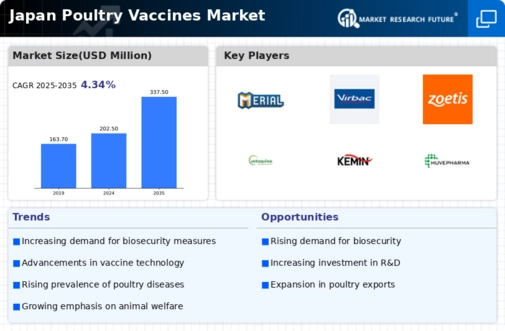Emerging Avian Diseases
The emergence of new avian diseases poses a significant challenge to poultry farming in Japan, driving the poultry vaccines market. Recent outbreaks of diseases such as avian influenza and Newcastle disease have highlighted the vulnerability of poultry to infectious agents. In response, the Japanese government has implemented stringent biosecurity measures and vaccination programs to mitigate these risks. The poultry vaccines market is expected to grow as farmers increasingly adopt vaccines to protect their flocks from these emerging threats. The need for effective vaccination strategies is underscored by the potential economic losses associated with disease outbreaks, which can reach millions of dollars in damages.
Increasing Poultry Production
The rising demand for poultry products in Japan is a primary driver for the poultry vaccines market. As the population grows and consumer preferences shift towards protein-rich diets, poultry production is expected to increase. In 2025, Japan's poultry production is projected to reach approximately 1.5 million metric tons, necessitating effective vaccination strategies to ensure healthy livestock. This growth in production directly correlates with the need for vaccines to prevent diseases that can affect poultry health and productivity. Consequently, the poultry vaccines market is likely to expand as producers seek to maintain high standards of animal welfare and food safety, thereby enhancing the overall efficiency of poultry farming.
Government Support and Funding
Government initiatives and funding aimed at enhancing animal health are pivotal for the poultry vaccines market. In Japan, the government has established various programs to support research and development in veterinary vaccines. This includes financial assistance for vaccine development and distribution, which encourages innovation in the poultry vaccines market. The government’s commitment to improving biosecurity measures and disease prevention strategies is likely to bolster the market. With an estimated budget allocation of ¥5 billion for veterinary health initiatives in 2025, the poultry vaccines market is expected to benefit from increased investment in vaccine research and implementation.
Consumer Awareness of Food Safety
Consumer awareness regarding food safety and animal welfare is influencing the poultry vaccines market in Japan. As consumers become more informed about the origins of their food, there is a growing demand for poultry products that are produced under stringent health standards. Vaccination plays a crucial role in ensuring the health of poultry, thereby reducing the risk of disease transmission to humans. This heightened awareness is prompting poultry producers to invest in vaccination programs, which in turn drives the poultry vaccines market. It is estimated that the market could grow by 10% annually as producers respond to consumer demands for safer and healthier poultry products.
Technological Innovations in Vaccine Development
Technological advancements in vaccine development are transforming the poultry vaccines market. Innovations such as recombinant vaccines and mRNA technology are being explored to enhance vaccine efficacy and safety. These advancements allow for the development of vaccines that can provide broader protection against multiple strains of pathogens. In Japan, research institutions are collaborating with private companies to accelerate the introduction of these novel vaccines into the market. The potential for improved vaccine formulations could lead to a market growth rate of 12% over the next five years, as producers seek to adopt the latest technologies to safeguard their poultry.



















Leave a Comment